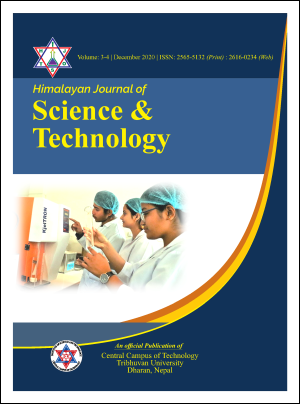Antibiogram Profiling and Thermal Inactivation of Staphylococcus aureus and Escherichia coli Isolated from Milk of Dharan, Nepal
DOI:
https://doi.org/10.3126/hijost.v4i0.33875Keywords:
Antibiogram profiling, Thermal Inactivation, Escherichia coli, Staphylococcus aureus, D-value, Z-valueAbstract
Milk is an excellent medium for the growth of many bacteria. This study aimed to determine antibiotic profiling and thermal inactivation of Staphylococcus aureus and Escherichia coli isolated from raw milk of Dharan. Total viable count, total Staphylococcal count, and total coliform count were carried out by conventional microbiological methods. Identification was done on the basis of Gram staining and biochemical tests. The antibiotic susceptibility test of the isolates carried out by the modified Kirby-Baur disc diffusion method. Thermal inactivation of S. aureus and E. coli were carried out by subjecting to thermal treatment in a water bath. Total plate count ranged from 204×104 CFU/mL to 332×105 CFU/mL. Total staphylococcal count and total coliform count ranged from 14×105 CFU/mL to 8×106 CFU/mL and 11×104 CFU/mL to 3×106 CFU/mL respectively. S. aureus showed an increasing resistance patterns towards Ampicillin, Cefotixin, Carbenicillin and Cefotaxime. Ciprofloxacin, Erythromycin, Amikacin, Gentamycin, Azithromycin, and Chloramphenicol were found to be effective against S. aureus. All the E. coli isolates were resistant to Ampicillin and least resistant to Cefotixin. Chloramphenicol, Amikacin, Azithromycin, and Nalidixic acid were found highly effective to E. coli. The D-values for S. aureus at 56°C, 58°C and 60°C were 1.36 min, 1.19 min, and 1.09 min respectively. The Z-value was 14.92°C. While D-values were obtained as 0.98 min, 0.75 min, and 0.57 min for E. coli at 56° C, 58° C and 60° C respectively, and Z-value was 9.75° C. Hence, S. aureus was found to be more heat resistant than E. coli.
Downloads
Downloads
Published
How to Cite
Issue
Section
License
© Himalayan Journal of Science and Technology
All rights reserved.




